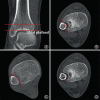In Different Gender Groups, What Is the Impact of the Fibular Notch on the Severity of High Ankle Sprain: A Retrospective Study of 360 Cases
- PMID: 37537373
- PMCID: PMC10549795
- DOI: 10.1111/os.13833
In Different Gender Groups, What Is the Impact of the Fibular Notch on the Severity of High Ankle Sprain: A Retrospective Study of 360 Cases
Abstract
Objectives: The role of the distal tibiofibular ligament in the occurrence of high ankle sprain (HAS) has been widely studied. But previous studies have overlooked the physiological and anatomical differences between males and females and have not further refined gender. Therefore, the impact of the anatomical morphology of fibular notch (FN) on HAS in different genders is still unclear. This study aimed to explore the impact of different types of FN on the severity of HAS and to estimate the prognosis of patients with HAS while excluding anatomical differences caused by gender.
Methods: One hundred and eighty patients with HAS were included in this study as the experimental group (i.e., HAS group). They were further divided into four groups according to gender and FN depth, with deep concave FN ≥ 4 mm and shallow flat FN < 4 mm. Another 180 normal individuals were set as the control group. The FN morphological indicators, tibiofibular distance (TFD), and ankle mortise indexes were measured and compared with those in HAS group. The independent t-test was used to compare continuous variables between groups, the intraclass correlation coefficient (ICC) was used to analyze the reliability of intra-observer measurement, and the Pearson correlation coefficient was used to verify the correlation between FN and the severity of HAS.
Results: In males with shallow flat type, the measurements of anterior tibiofibular distance (aTFD), middle tibiofibular distance (mTFD), posterior tibiofibular distance (pTFD), front ankle mortise width (fAMW), middle ankle mortise width (mAMW), posterior ankle mortise width (pAMW), and depth of ankle mortise (DOAM) in HAS group were significantly larger than those in normal group (p < 0.05). In male patients with deep concave type, the measurements of aTFD, mTFD, fAMW, mAMW, and DOAM were significantly larger than those in normal group (p < 0.05). Among female patients with shallow flat type, the measurements of aTFD, mTFD, pTFD, fAMW, mAMW, pAMW, and DOAM were found to be significantly larger than those in normal group (p < 0.05). Among female patients with deep concave type, the measurements of mTFD, pTFD, fAMW, mAMW, and DOAM were found to be significantly larger than those of the normal group (p < 0.05). The depth of FN was negatively correlated with TFD, and the AOFAS score of patients with shallow flat type was significantly lower than that of patients with deep concave type after treatment (p < 0.05).
Conclusions: In different gender groups, compared with the normal controls, the TFD and partial ankle mortise indices were significantly different in HAS patients. Moreover, FN depth was negatively correlated with TFD, and the AOFAS score of shallow flat patients was significantly lower than that of deep concave patients. These suggested that shallow flat FN may be associated with more severe distal tibiofibular ligament injury and ankle mortise widening, leading to poorer prognosis. This should be taken seriously in clinical practice.
Keywords: Ankle Mortise; Distal Tibiofibular Syndesmosis; Fibular Notch; High Ankle Sprain; Tibiofibular Distance.
© 2023 The Authors. Orthopaedic Surgery published by Tianjin Hospital and John Wiley & Sons Australia, Ltd.
Conflict of interest statement
The authors declare no conflicts of interest in this study.
Figures


References
-
- Baldassarre RL, Pathria MN, Huang BK, Dwek JR, Fliszar EA. Periosteal stripping in high ankle sprains: an association with osteonecrosis. Clin Imaging. 2020;67:237–45. - PubMed
-
- Mauntel TC, Wikstrom EA, Roos KG, Djoko A, Dompier TP, Kerr ZY. The epidemiology of high ankle sprains in National Collegiate Athletic Association Sports. Am J Sports Med. 2017;45:2156–63. - PubMed
-
- Walden M, Hagglund M, Ekstrand J. Time‐trends and circumstances surrounding ankle injuries in men's professional football: an 11‐year follow‐up of the UEFA champions league injury study. Br J Sports Med. 2013;47:748–53. - PubMed
-
- Randell M, Marsland D, Ballard E, Forster B, Lutz M. MRI for high ankle sprains with an unstable syndesmosis: posterior malleolus bone oedema is common and time to scan matters. Knee Surg Sports Traumatol Arthrosc. 2019;27:2890–7. - PubMed
MeSH terms
Grants and funding
- 2021ZYD0078/Central Funds Guiding the Local Science and Technology Development General Program of Sichuan Provincial Science and Technology Department
- 2023MS248/General Project of Sichuan Traditional Chinese Medicine Administration Traditional Chinese Medicine Research Special Project (Fundamentals of Traditional Chinese Medicine)
- 2022HJXNYD04/Hejiang People's Hospital - Southwest Medical University Science and Technology Strategic Cooperation Project (major project)
- 82004458/National Natural Science Foundation of China (Youth Science Foundation Project)
- 2022-CXTD-08/Scientific Research Cultivation Project of The Affiliated Traditional Chinese Medicine Hospital of Southwest Medical University
LinkOut - more resources
Full Text Sources
Medical
Miscellaneous

